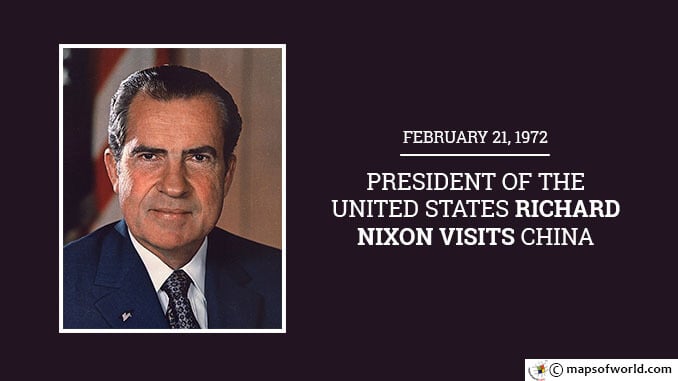In what was described by President Richard Nixon’s own words as “the week that changed the world”, he and the First Lady Pat Nixon undertook an unprecedented historic weeklong tour of the People’s Republic of China (PRC) starting February 21, 1972. The United States and China had no diplomatic relations till then and President Nixon became the first American president to visit the country, well known for its isolation. Apart from giving most countrymen their first glimpse of PRC through the televised footage, Nixon forged a diplomatic relationship that not only wooed China’s support in an escalating Cold War, but also paved the way for much future collaboration. Starting from the 1949 revolution that set up the PRC, till about the mid-1960s most American politicians had been staunch in their opposition of the PRC, duly failing to recognize the administration as legitimate – while recognizing the Taiwanese government as the legitimate Republic of China. Richard Nixon, however, stressed as part of his election campaign that it was completely to America’s advantage to build up better relations with the PRC. Upon being elected to the Oval Office, Nixon worked out a comprehensive plan with the National Security Adviser, Henry Kissinger. After an exchange of a number of diplomatic overtures, Kissinger flew on July 1971 to Beijing to meet Chinese Premier Zhou Enlai. This visit was not revealed to the press and is believed to have been a preparation for the President’s visit. Armed with an invitation for the president, Kissinger returned and plans for a presidential visit were revealed along with a loosening of the trade embargo on China. The visit was an eight day media extravaganza. The President and the First Lady were continuously accompanied by an entourage of the American Press corps – with television gaining precedence. The Americans back home indulged in a week-long series of spectacular and colorful images from the PRC, something they had been denied for over two and half decades. President Nixon played out his best dramatic gestures, emerging alone from the plane to shake hands with Premier Enlai before allowing Kissinger and Secretary of State, William Rogers to descend. Surprises awaited them too – the President was immediately ushered to a previously unannounced meeting with Chairman Mao. Kissinger would later refer to this meeting as an ‘encounter with history’. Following this directly was the formal welcome banquet hosted by Premier Enlai. The spectacular banquet unfolded with innumerable courses and unending toasts and was telecast directly from the Great Hall of the People to the US. The Chinese bands played American favorites including ‘Home on the Range’ and ‘America the Beautiful’ wooing the hearts of millions of Americans in the US. The President spent the entire week in meetings with Enlai and Chinese officials. Apart from this he attended numerous cultural performances and other formal banquets. He undertook visits to Chinese architectural heritage sites such as the Forbidden City, Ming Tombs, and the Great Wall of China. The press entourage, cut out from the President’s formal meetings, accompanied the First Lady as she travelled across the country visiting schools, hospitals, communes, and factories. On February 28, the final day of Nixon’s visit to the PRC, the US and Chinese authorities jointly issued the “Shanghai Communique”. The communiqué was a pledge on the part of both countries to work towards normalizing relations. All criticism regarding a “sellout” of Taiwan was drowned in the spectacular success of the visit. Nixon’s visit went a long way in opening the door for cordial American-Chinese relations. Normalcy and subsequent diplomacy would still take over five years to be restored but the visit immediately tilted the Cold War balance, making the PRC an ally of the US. In the course of the visit, Premier Enlai had also urged the US to negotiate an early peace in Vietnam but abstained from endorsing North Vietnam’s political demands. Nixon promised to reduce US military presence in Taiwan. While the North Vietnam was fueled by fears and launched a major offensive in March 1972, the visit ultimately led to the end of the Vietnam War. The visit was a pleasant but unexpected one and since “Nixon goes to China” has become a figure of speech to denote an unexpected action especially by a politician. You may also like : February 21 1848 – The Communist Manifesto is Published for the First Time February 21, 1848 – Communist Manifesto is published
February 21 1972 – President of the United States Richard Nixon visits China
In what was described by President Richard Nixon’s own words as “the week that changed the world”, he and the First Lady Pat Nixon undertook an unprecedented historic weeklong tour…
769

 February 21, 1848 – Communist Manifesto is published
February 21, 1848 – Communist Manifesto is published